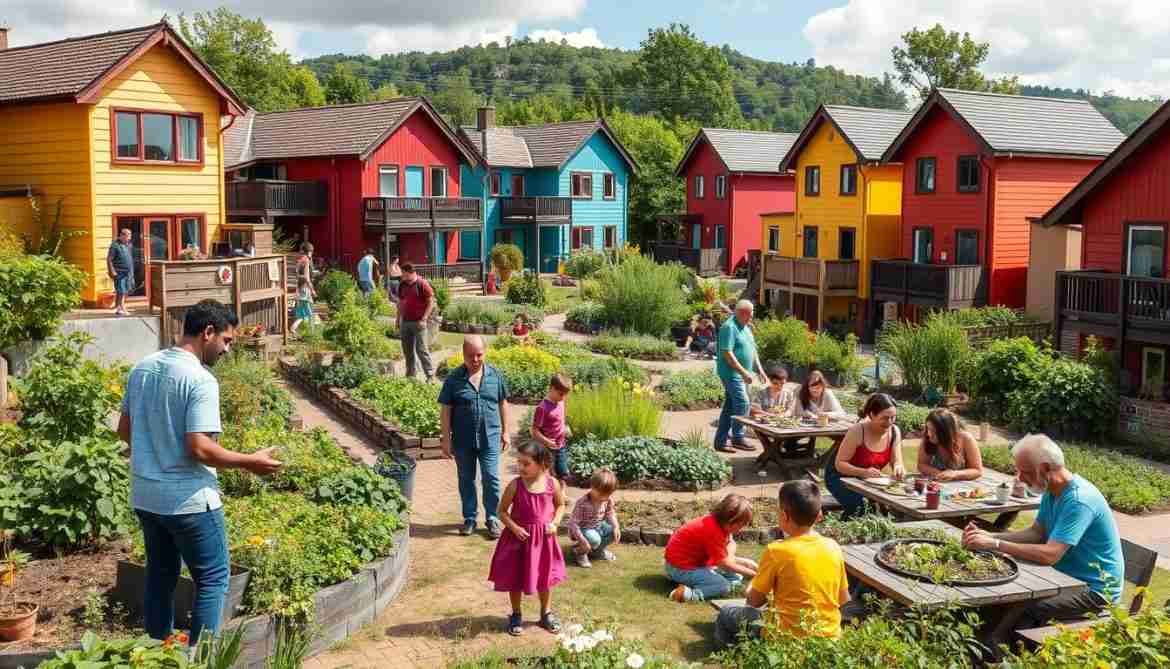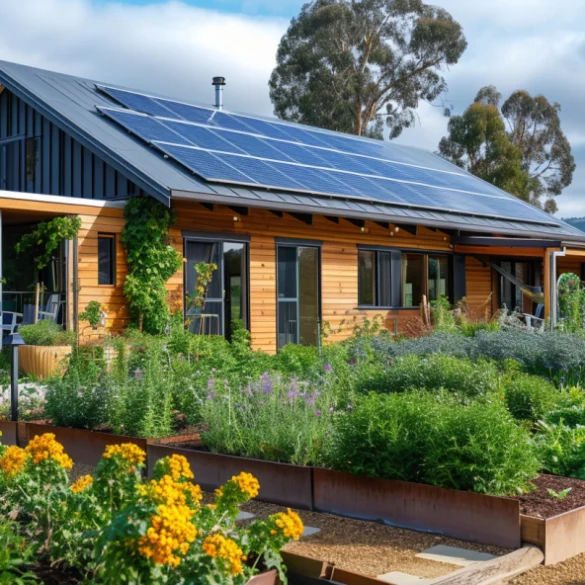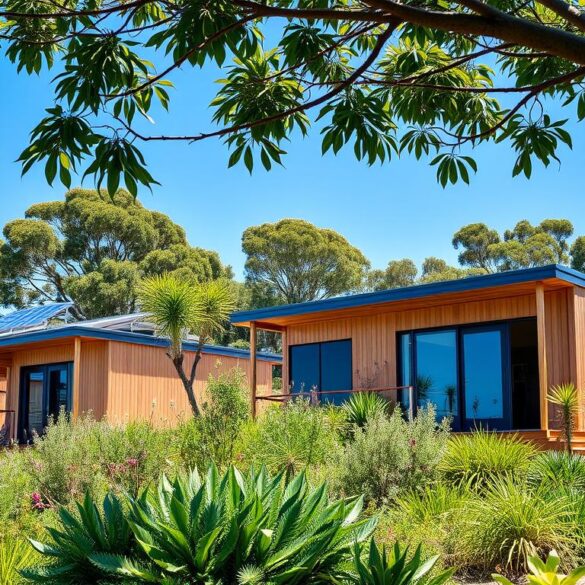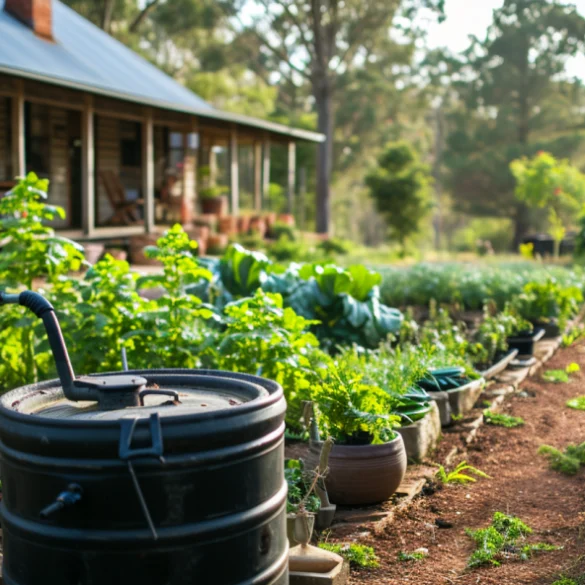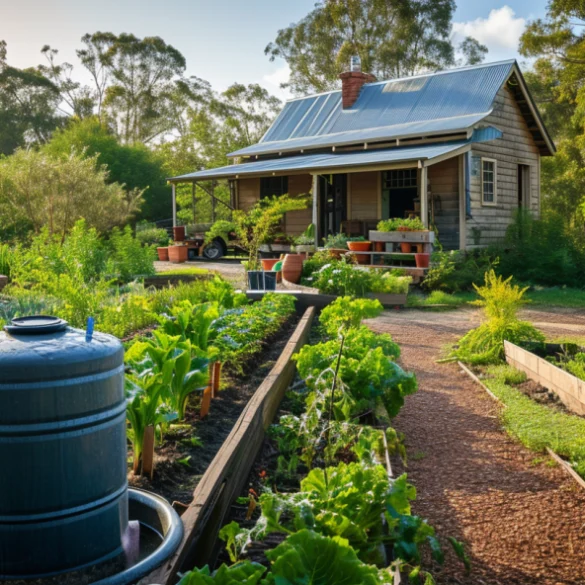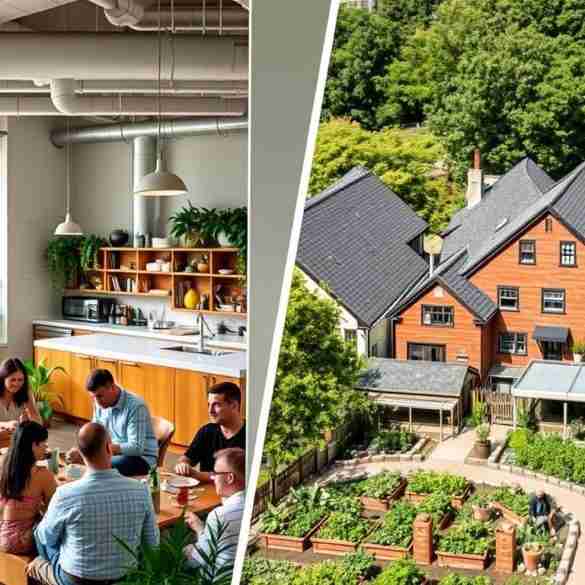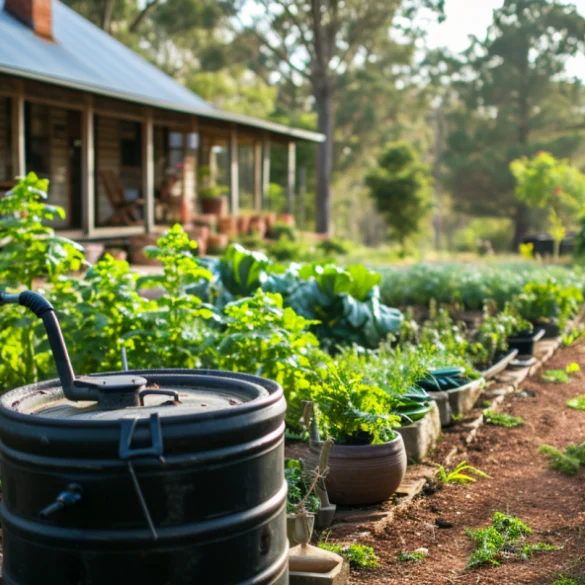Imagine living in a world where neighbors support and share your values. A world where you have access to shared resources and sustainable living. This is co-housing, and it’s becoming more popular as a housing alternative.
Co-housing, or communal living, offers many benefits. It’s for those who want a more connected and fulfilling life. You get to enjoy shared amenities, lower costs, and a strong social support system.
One big plus of co-housing is the strong community it builds. People here engage in activities and decisions together. This creates deep connections and fights loneliness, common in today’s world.
Co-housing also focuses on being green and self-sufficient. Many have community gardens, renewable energy, and share resources. Living here means you can lower your environmental impact while still enjoying modern comforts.
Co-housing is great for anyone, whether you’re young, starting a family, or a senior. It offers benefits like social connections, sustainable living, and shared resources. This makes co-housing the future of community living.
Key Takeaways
- Co-housing promotes a strong sense of community and belonging among residents
- Shared resources and amenities in co-housing can lead to cost savings and a reduced environmental impact
- Co-housing offers a supportive and collaborative living environment for individuals and families of all ages
- Sustainable living practices are often prioritized in co-housing communities
- Co-housing is gaining popularity as an alternative to traditional housing models, with benefits for social connection, sustainability, and overall well-being
Social Benefits of Co-Housing
Co-housing communities focus on social interaction and support. They build strong social networks and reduce loneliness. This makes co-housing a great place to live.
Fostering Strong Social Networks
Co-housing lets people form deep connections with neighbors. They join in on activities like dinners and games. This creates a strong community feeling.
Every resident talks to their neighbors daily or weekly. Before moving in, only 30% did. This shows how co-housing strengthens relationships.
Shared Support Systems
Co-housing offers practical and emotional support. Neighbors become like friends, ready to help with tasks. This is especially helpful for those who might feel isolated.
| Metric | Before Moving In | After Moving In |
|---|---|---|
| Residents Feeling Lonely | 40% | 0% |
| Residents Interacting with Neighbors Daily/Weekly | 30% | 100% |
| Residents Comfortable Asking Neighbors for Help | N/A | 100% |
Reducing Loneliness and Isolation
Co-housing fights loneliness and isolation. Studies show no one feels lonely in these communities. This is a big change from before.
These communities are close-knit. They offer many social chances. This improves mental health and overall happiness.
Positive changes in physical and mental health, social connections, engagement with the community, and trust in neighbors were observed through surveys and interviews after residents moved in.
Co-housing has many benefits but also some downsides. It might mean less privacy and needing to compromise. Yet, for those wanting a supportive home, the benefits often outweigh the drawbacks.
Financial Benefits of Co-Housing
Co-housing offers many financial benefits. It’s a great choice for those looking to save money. By sharing costs and amenities, residents can enjoy big savings. Sustainable Home Magazine says it’s not just about money. It’s also about living better and more sustainably.

Sharing Housing Costs
Co-housing lets people split housing costs. In a typical community, 20 to 30 families own the property together. This way, everyone pays less for their home than they would alone.
Co-housing homes also use green tech like solar panels. This cuts down on utility bills. So, residents save money every month and in the long run.
Access to Shared Amenities
Co-housing also means shared amenities. Residents have their own homes but share a common house. This house has kitchens, living areas, and more. It saves money because everyone doesn’t need to buy their own stuff.
There are also outdoor spaces like gardens and courtyards. These areas are for everyone to enjoy. They help build community and save money.
Financial Flexibility and Long-Term Savings
Co-housing offers financial freedom. By sharing costs, residents can save for other things. They can invest in education or retirement. It’s a way to live more affordably.
As of 2019, the average American household was spending 33.8 percent of its budget on housing-related expenses. Co-housing presents an opportunity to reduce this financial burden and allocate resources towards other important aspects of life.
Co-housing communities have been around for decades. They show that it’s a stable and sustainable way to live. The shared ownership and decision-making keep these communities strong financially.
Co-housing has its pros and cons. But the financial benefits are clear. It’s a smart choice for those wanting to save money and live in a community.
Environmental Sustainability in Co-Housing
Co-housing communities lead the way in sustainable living. They offer many environmental benefits for a greener future. By working together and using eco-friendly practices, residents cut down their ecological footprint. This promotes a sustainable lifestyle.
Shared Resources and Reduced Waste
Co-housing is great because it shares resources, cutting down on waste. People share spaces, appliances, and tools. This saves money and helps the environment.
Residents also share meals and buy in bulk. This cuts down on packaging waste. Cooking and eating together helps use food better and supports local farmers.
Energy Efficiency in Shared Spaces
Co-housing focuses on energy-efficient shared spaces. They use renewable energy and sustainable design. This includes passive solar design and energy-saving appliances.
Dr. Penny Clark’s research shows co-housing can cut carbon emissions by up to 63%. This is thanks to residents’ efforts to live sustainably and invest in green tech.
| Community | Operational Emissions Compared to UK Average |
|---|---|
| Co-housing Community A | 37% |
| Co-housing Community B | 45% |
| Co-housing Community C | 52% |
Community Gardens and Local Sourcing
Many co-housing communities have gardens for growing food. These gardens provide fresh produce and connect people with nature. They also support local farming.
By gardening together, residents often choose plant-based diets. This choice helps reduce their carbon footprint. Co-housing communities also organize meals that are good for the planet.
“Living in a co-housing community has transformed the way I think about sustainability. By sharing resources, growing our own food, and supporting each other in eco-friendly practices, we are making a tangible difference in the world.” – Sarah, co-housing resident
Co-housing’s environmental benefits are not just for the community. It can change how we plan cities and build homes. By showing the value of living together, co-housing encourages others to live more sustainably.
Mental and Physical Health Benefits
Living in a cohousing community has many benefits for your health. It helps you feel part of a community and encourages active living. This leads to a healthier life for people of all ages.
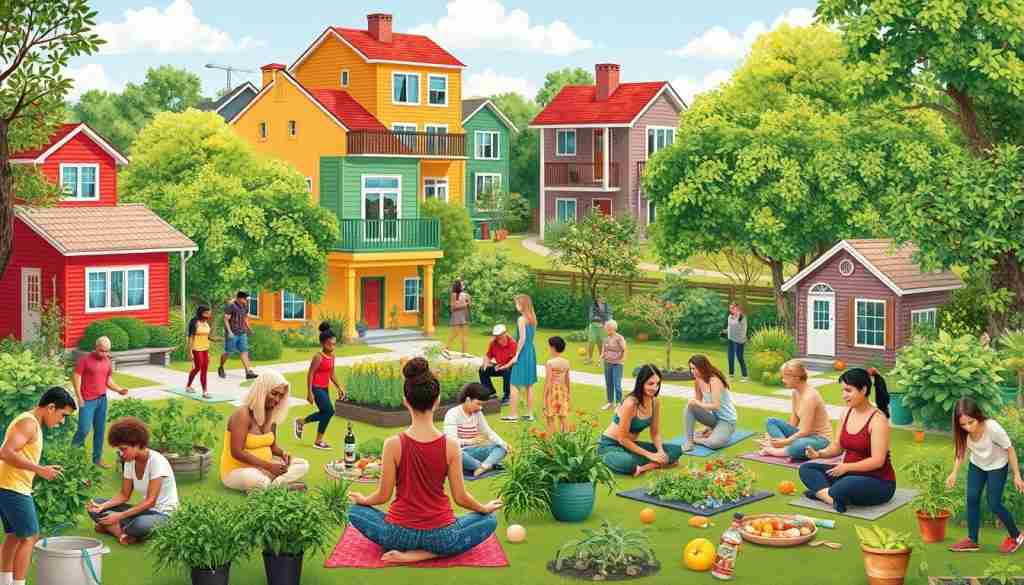
Active Lifestyles in Co-Housing
Cohousing promotes physical activity through green living. Walking or biking to shared spaces is common. This reduces the risk of chronic diseases and boosts fitness.
Intentional communities also focus on clean living spaces. This helps avoid health risks from environmental toxins. It’s good for your lungs and overall health.
Mental Wellbeing through Social Engagement
One big plus of cohousing is its effect on mental health. A study by Norwegian scientist Bjørn Grinde found high satisfaction levels. People in these communities are happier than most North Americans.
Being part of a tight-knit community lowers stress and fights loneliness. This is crucial for seniors, who often face social isolation.
Access to Shared Wellness Facilities
Cohousing communities often have shared wellness spaces. These include fitness centers, yoga studios, and meditation areas. It’s easy for residents to stay healthy with these amenities nearby.
Some communities even offer discounts on healthcare services. This is a big help for seniors and those living far from healthcare.
| Aspect | Cohousing | Traditional Housing |
|---|---|---|
| Residents Requiring Care (Age 50+) | 16% | 33% |
| Residents Able to Age in Place | 8-10 years longer | N/A |
| Incidence of Chronic Diseases | Lower | Higher |
When weighing cohousing pros and cons, the health benefits are clear. Studies show it boosts well-being, especially for seniors. Cohousing lets people stay in their homes longer and enjoy better health than those in traditional settings.
Co-Housing for Families
Families are finding out how great co-housing is. It offers a supportive place to raise kids, with features that help kids make friends and share experiences. Co-housing lets families enjoy living together while keeping their own space.
Childcare Support in Co-Housing
One big plus of co-housing for families is the childcare help. Many co-housing groups share childcare duties. This makes it easier for parents to work and take care of their kids.
Family-Friendly Co-Housing Communities
Co-housing places are made for families, with fun features for kids and parents. These intentional community benefits include:
- Safe outdoor play areas
- Shared recreational facilities
- Common spaces for family gatherings
- Community gardens
- Shared meals and events
Living in co-housing means families feel part of a community. They get support from neighbors, making their homes feel like a bigger family.
Educational Benefits of Community Living
Children in co-housing learn a lot. They pick up skills like working together and solving problems. These are important for growing up and doing well in life.
“Living in a co-housing community has been a game-changer for our family. Our children have formed incredible friendships and are learning so much from the diverse experiences and perspectives of our neighbors.” – Sarah, co-housing resident
| Age Group | Educational Benefits | Social Benefits |
|---|---|---|
| Toddlers (1-3 years) | Early socialization, language development | Playdates, shared childcare |
| Preschoolers (3-5 years) | Cooperative play, problem-solving skills | Friendships, community events |
| School-age children (5-12 years) | Collaborative learning, project-based activities | After-school programs, mentorship |
| Teenagers (13-18 years) | Leadership opportunities, community service | Peer support, intergenerational connections |
More families are seeing the good in co-housing. It’s a new way to live that’s connected and fulfilling. It’s becoming a popular choice for those wanting a better life.
Co-Housing for Seniors
As the U.S. population ages, senior co-housing is becoming a popular choice. It lets older adults stay independent while enjoying the social support advantages and community living benefits of co-housing. With over 45 senior co-housing communities across the country, it’s a growing alternative to traditional retirement homes.
Senior co-housing communities are built for a supportive, tight-knit environment. They have 20 to 40 homes, with shared common spaces. These communities are for people aged 55 and up, offering co-housing advantages for active, engaged living.
Aging in Place in Co-Housing
Senior co-housing lets people age in place. These communities have features like single-level homes and grab bars. This helps seniors stay independent longer, avoiding the need for assisted living or nursing homes.
Intergenerational Living
Senior co-housing also welcomes intergenerational living. This means seniors can interact with and learn from younger people. It helps reduce loneliness and improves mental and emotional health.
Health and Support Systems for Seniors
Co-housing communities offer health and support systems for seniors. Neighbors help each other with daily tasks or in emergencies. This support can reduce the health risks of loneliness, which is as harmful as smoking or obesity.
“Living in a senior co-housing community has been a life-changing experience. I feel supported, engaged, and part of a vibrant community that truly cares about my well-being.” – Mary, 72, Silver Sage Village resident
Senior co-housing communities also encourage learning and skill development. Residents can do community service, art, woodworking, and music classes. This promotes social engagement and well-being. Skills learned include property management and nonviolent communication.
| State | Number of Senior Co-Housing Communities |
|---|---|
| California | 12 |
| Colorado | 5 |
| North Carolina | 4 |
| Washington | 4 |
| Oregon | 3 |
Senior co-housing is growing across the U.S., with more in California, Colorado, North Carolina, Washington, and Oregon. These communities offer different housing options, from affordable to luxury. Some, like Village Hearth Cohousing in Durham, North Carolina, are LGBTQ-friendly, welcoming all seniors.
Senior co-housing is becoming a popular choice for older adults. It offers co-housing advantages, community living benefits, and social support advantages. Seniors can enjoy their golden years in a supportive, vibrant environment that promotes health, happiness, and independence.
Co-Housing and Sustainable Urban Development
Cities are growing fast, and we need to make them sustainable. Co-housing is a great way to solve urban problems. It offers many benefits and helps people live better together. By using co-housing in city planning, we can make neighborhoods better for everyone and the planet.
Urban Planning with Co-Housing
Urban planners see co-housing as a way to make cities better. It helps create communities that are lively and green. This way, cities become more livable and sustainable for all.
Sustainable Infrastructure
Co-housing focuses on green features like solar power and green spaces. These help cities be kinder to the environment. For example, Aria Denver in Colorado shows how co-housing can help both people and the planet.
| Co-Housing Project | Location | Sustainable Features |
|---|---|---|
| The Lane | Cambridge, England | Child-friendly, car-free “street” anchoring the community |
| Takoma Village | Washington, D.C. | 43 residential units ranging from one-bedroom apartments to four-bedroom townhouses |
| Aria Denver | Denver, Colorado | 9 out of 28 homes are permanently affordable for families making 80% of the area median income |
Community-Based Solutions to Urban Challenges
Co-housing helps solve city problems by working together. It can tackle issues like traffic and food access. For instance, sharing cars and growing food together can make a big difference.
“Co-housing offers a unique opportunity to create sustainable, socially connected communities within urban areas. By prioritizing sustainable infrastructure, community-based solutions, and collaborative living, co-housing can help cities meet the challenges of the 21st century and beyond.” – Susan Powers, developer of Aria Denver co-housing project
More cities are turning to co-housing for a better future. It builds communities that are green, connected, and strong. Co-housing can change how we live in cities and make our future brighter.
The Role of Technology in Co-Housing
Technology is becoming key in co-housing, making it more sustainable and community-focused. It helps manage these living spaces smoothly. From smart homes to digital platforms, tech is changing how we live together.
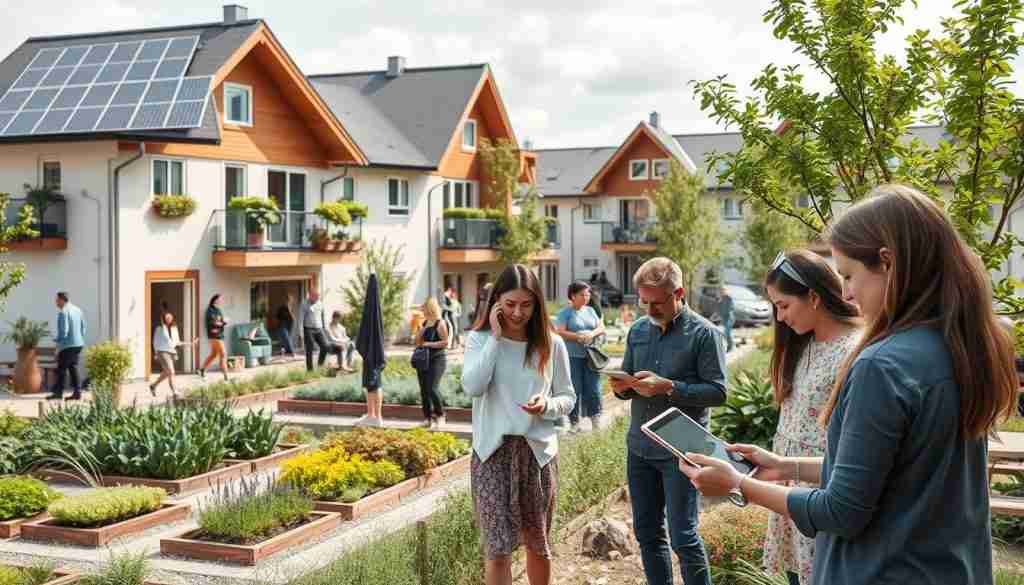
Smart Living Spaces
Technology is making co-housing better through smart homes. These homes save energy, are more secure, and are easier to use. For example, smart thermostats adjust the temperature based on who’s home and the weather.
Smart locks and cameras also offer peace of mind. They let residents check in on their homes and let others in when needed.
Digital Platforms for Community Management
Technology is also changing how co-housing communities manage themselves. Digital platforms and apps help residents communicate and share resources. This builds a strong community spirit.
These platforms include:
- Community calendars for events and meetings
- Discussion forums for sharing ideas
- Tools for sharing items like tools and appliances
- Systems for paying shared expenses
- Ways to request maintenance and repairs
These tools make managing the community easier. They ensure everyone has access to what they need to thrive.
Virtual Collaboration in Co-Housing Communities
Technology also helps co-housing communities make decisions together. Virtual meetings and online voting let everyone participate, no matter where they are. This is great for big communities or those with travelers.
| Technology | Co-Housing Advantages |
|---|---|
| Smart Home Systems | Energy efficiency, security, convenience |
| Digital Management Platforms | Streamlined operations, resource sharing, community engagement |
| Virtual Collaboration Tools | Inclusive decision-making, remote participation |
As tech advances, it will be even more crucial for co-housing. It will help make these communities more sustainable, efficient, and connected. This will benefit both residents and the environment.
How Co-Housing Builds Resilience
In today’s world, co-housing communities stand out as strong and supportive. They offer a sense of unity and help during tough times. The benefits of living together go beyond just social connections. They also bring financial and emotional stability when needed.
Coping with Crises as a Community
Co-housing helps residents face crises like natural disasters or economic downturns. The community’s tight bonds allow for sharing resources and skills. For example, Pasadena Trails in South Texas handled Hurricane Harvey well thanks to their drainage systems.
Financial and Emotional Support Systems
Co-housing provides a financial and emotional safety net. Neighbors help each other during hard times, like job loss or illness. This support reduces stress and boosts well-being. It also helps solve the affordable housing problem, like the Thunder Valley CDC program in Pine Ridge.
“The majority of resident-owned mobile home co-ops are concentrated in the Northeast and Pacific Northwest, with organizations like ROC-NH helping connect communities in New Hampshire with state resources to set up solar projects.”
Flexibility in Challenging Times
Co-housing communities are flexible and adaptable. Residents work together to solve problems, like sharing childcare or carpooling. This teamwork makes the community stronger.
| Community | Resilience Initiative | Impact |
|---|---|---|
| Lakeville Village, NY | Community solar project | Benefiting residents and local businesses for over two years |
| Evergreen Cooperatives, OH | Green initiatives (laundry facilities, solar panels, urban greenhouses) | Over 200 workers employed, contributing to systemic resilience |
| Pasadena Trails, TX | Installed drainage systems | Better flood protection during Hurricane Harvey |
Co-housing has its advantages and disadvantages, but its resilience is clear. It builds strong support systems, promotes financial stability, and encourages flexibility. As we face a complex world, the value of community living will only grow. It’s a key to a more resilient future for everyone.
Co-Housing and Its Cultural Impact
Co-housing is becoming more popular worldwide. It’s changing how we think about living together and what community means. It’s making us see the value of shared spaces, resources, and duties.
Shifting Social Norms Around Living
Co-housing shows the power of living with purpose. People choose to focus on social bonds, being green, and helping each other. They’re showing that you can have privacy and still live in a community.
This model blends private and shared areas. It lets people keep their independence but also build a strong community. This change is making more people want to live in a way that’s more connected and caring.
The Global Growth of Co-Housing
Co-housing is growing all over the world. It shows a big change towards living in a way that’s better for the planet and people. As more people learn about it, they’re drawn to its benefits.
| Co-Housing Model | Key Features |
|---|---|
| Cluster Housing | Private homes encircling a central communal space |
| Ecovillages | Emphasis on sustainability and eco-friendly initiatives |
| Senior Co-Housing | Age-appropriate living environment for elderly |
As co-housing spreads across different places and cultures, it’s changing how we see homes, communities, and our surroundings. It shows that living together can work well, thanks to good rules and ways of making decisions.
Final Thoughts
Co-housing offers many benefits, from building strong social networks to saving money and helping the environment. With over 160 communities in the US and 130 more in development, it’s a growing trend. This shows that more people want to live in a way that supports community and sustainability.
Co-housing lets people feel a strong sense of belonging and support. Residents make decisions together and share activities. This builds real connections and a true community feeling.
Co-housing also tackles the big issues of affordable and sustainable housing. By sharing spaces and resources, it improves life quality and reduces environmental harm. It even helps with finances, making housing more accessible.
Looking ahead, co-housing will likely become even more popular. It offers a fulfilling, connected lifestyle that values community and sustainability. If you’re interested in a more meaningful way of living, co-housing is worth exploring.

